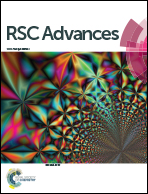Graphene oxide–noble metal (Au, Pt, and Pd) nanoparticle composites as optical limiters
Abstract
A series of graphene oxide (GO)/noble metal (Au, Pt, and Pd) nanoparticle (NP) composites were synthesized via a one-step hydrothermal reaction of HAuCl4, H2PtCl6, and Pd(C2H3O2)2 in the presence of GO. The metal NPs with different average sizes and distributions were uniformly deposited onto the GO surface. The GO structure was conserved after loading with Au, Pt, and Pd NPs. The corresponding nonlinear optical (NLO) and optical limiting (OL) properties were investigated using an open-aperture Z-scan technique with nanosecond pulses at 532 nm. The results show that the NLO and OL properties were significantly enhanced after the inclusion of metal NPs on the GO surface because of nonlinear scattering (NLS) effects. These enhancements depend on the type of loading metal NPs. The GO/Au-NP composite exhibits the optimal NLO and OL performances among the studied composites because of the surface plasmon resonance of the Au NPs. Thus, the NLO and OL effects of the two-dimensional GO can be effectively modified by absorbing different metal NPs on its surface. The synthetic NLO and OL properties in the GO/metal NP composites originate from the reverse saturable absorption in the GO sheets and the NLS in metal NPs. All of the results indicate that these composites can be used in optoelectronic applications.


 Please wait while we load your content...
Please wait while we load your content...